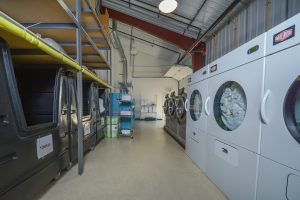Setting up an in-house laundry facility is a big commitment in terms of finances, resources, and management. And it can be a daunting task, but in the long run, it is worth every penny. An in-house laundry facility can reduce your costs by 50 percent or more per pound, and it gives you control over the quality of linens you provide.
It All Starts with Research
Connect with fellow Vacation Rental Managers (VRMs) who already have in-house laundry facilities and attend industry events to learn about best practices. You will find that many VRMs are happy to share what they have learned about managing laundry in-house laundry and will even let you and your team train with them. I cannot stress that enough. I spent time with five different vacation rental companies and spent over a year researching linens and chemical suppliers before I started my first facility.
What You Will Need
 Not only do you need to learn how facilities are run in the industry and how equipment works, but you also need to have an itemized breakdown of equipment you will need. From washers and dryers to totes and carts, there are numerous items that are necessary to get the job done.
Not only do you need to learn how facilities are run in the industry and how equipment works, but you also need to have an itemized breakdown of equipment you will need. From washers and dryers to totes and carts, there are numerous items that are necessary to get the job done.
At Taylor-Made Deep Creek Vacations, we started our laundry facility with one 70-pound capacity washer and one 125-pound capacity dryer to service up to 70 properties. We then expanded our operation into a larger space. The equipment listed below is what we currently use and is adequate for servicing about 300 homes:
- Three 60-pound capacity washers
- Three 75-pound capacity dryers
- One commercial ironer
- One commercial laundry shrink wrapping machine
- Instant hot water
- One 1,000-gallon storage tank
As our company has recently grown to manage over 350 properties, we have plans to replace some of our current equipment with three 100-pound washers and three 175-pound dryers.
I suggest investing in a commercial ironer when purchasing equipment. It reduces drying time, requires only two staff members for operation, and creates that crisp, clean look that guests love. We also chose to invest in a shrink wrap machine that keeps sheet sets together and free of dust while easing transport.
Also, keep in mind that this list does not include other costly items like office furniture, signage, tile work, wiring, computers, phones, etc. And, if you are not on city water, you may also need to budget for water treatment equipment and service. Water that has too much iron can discolor your linens. So be sure to consider all of this in your budget as well.
The Right Location
Finding the right space to house your facility is a critical piece of the puzzle. Your warehouse space needs to include an area that can act as a dedicated folding room and storage room for clean linens. You never know when you might go from managing 250 homes to 350 homes overnight like we did this year. I suggest about 1,200–1,500 square feet for a facility that services approximately 350 homes.
Hindsight is twenty-twenty, and looking back, there are some things I would have definitely done differently. While our warehouse space has plenty of room throughout most of the year, during the busy summer season, when we have a lot of back-to-back reservations, I have to rent a storage space for dirty linens. Don’t underestimate how much space you will need just for linen storage—both clean and dirty.
At Taylor-Made, our laundry facility meshes well with our housekeeping department. To help keep costs low, our housekeepers transport linens back and forth from our laundry facility. Everything is bagged and wrapped, and linens and towels are packaged separately so that they can be efficiently distributed throughout a home.
 When housekeepers are doing deep cleans, they are able to bring comforters and blankets back to our laundry facility instead of taking them to a laundromat. This is a big timesaver that aids in completing a thorough cleaning of a home more efficiently.
When housekeepers are doing deep cleans, they are able to bring comforters and blankets back to our laundry facility instead of taking them to a laundromat. This is a big timesaver that aids in completing a thorough cleaning of a home more efficiently.
While this may seem like a lot of information, I have barely scratched the surface of all of the detail involved in an endeavor as large as adding an in-house laundry facility. But, I can tell you that what may seem like a major investment can quickly become a profit center for your company. For example, the current industry average cost per pound is about 55 cents, but by optimizing our in-house laundry facility, we are able to operate at an average of 6 cents below that.
At the risk of repeating myself, I hope that if you take away any piece of advice from this article, it is that you should make sure to do your homework—and do it well—before you make any financial commitments. Utilize the experience that others have had in this same arena and take advantage of educational opportunities at industry events. Fellow vacation rental managers tend to be generous with sharing their experiences in order for you to learn the do’s and don’ts and pros and cons of bringing laundry in-house.



I am with padre Escape vacation rental and wonder if I could speak with someone in your laundry department about your success with a flat ironer as for as brand do’s and don’t.
Thaks
Terry Cox
361 949 7077
I am curious how your washers are programmed. Specifically the time for each cycle (i.e. Sheets, Towels, etc) I just had new chemical pumps installed and the vendor increased my cycle times to approximately 45 minutes per. It is killing my productivity and I would love to hear your experience.